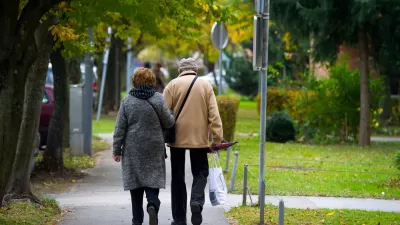It's not just the Sun Cities of America that are planning for how to meet the needs of the country's coming bulge in its over-65 population. Ryan Holeywell highlights how some cities are adapting their built environments for an aging population.
Widened sidewalks, crouching buses, safer crosswalks, senior bicycling groups, and zoning changes to allow "granny flats" are just a sample of the ways in which communities across America are planning to meet the needs of the 80+ percent of baby boomers who plan to age in place.
"Across the country, urban planners and transit officials are realizing
that the wave of boomer retirees will transform the way cities look,
from the way they grow and sprawl to minutiae such as curb heights and
the fonts on street signs," writes Holeywell.
"We're in a period of transition that's
pretty dramatic," says David Dixon, who leads the planning and urban
design practice at the Boston-based firm Goody Clancy. "You look at
major metro areas, and sometimes a third or more of their growth for the
next 30 years is folks over 65. That's a hugely [significant] and rapid
transition."
"The bottom line, planners say, is that city and county governments face a
growing challenge: how to design a community for a population they
haven't had to cater to in the past. If they come up with the right
answer, they can help aging residents lead fulfilling lives and remain
engaged and active, even in their senior years. But if they fail, they
risk alienating and isolating a rapidly growing cohort of taxpayers."
FULL STORY: How Will Boomers Reshape U.S. Cities?

Planetizen Federal Action Tracker
A weekly monitor of how Trump’s orders and actions are impacting planners and planning in America.

Map: Where Senate Republicans Want to Sell Your Public Lands
For public land advocates, the Senate Republicans’ proposal to sell millions of acres of public land in the West is “the biggest fight of their careers.”

Restaurant Patios Were a Pandemic Win — Why Were They so Hard to Keep?
Social distancing requirements and changes in travel patterns prompted cities to pilot new uses for street and sidewalk space. Then it got complicated.

Platform Pilsner: Vancouver Transit Agency Releases... a Beer?
TransLink will receive a portion of every sale of the four-pack.

Toronto Weighs Cheaper Transit, Parking Hikes for Major Events
Special event rates would take effect during large festivals, sports games and concerts to ‘discourage driving, manage congestion and free up space for transit.”

Berlin to Consider Car-Free Zone Larger Than Manhattan
The area bound by the 22-mile Ringbahn would still allow 12 uses of a private automobile per year per person, and several other exemptions.
Urban Design for Planners 1: Software Tools
This six-course series explores essential urban design concepts using open source software and equips planners with the tools they need to participate fully in the urban design process.
Planning for Universal Design
Learn the tools for implementing Universal Design in planning regulations.
Heyer Gruel & Associates PA
JM Goldson LLC
Custer County Colorado
City of Camden Redevelopment Agency
City of Astoria
Transportation Research & Education Center (TREC) at Portland State University
Camden Redevelopment Agency
City of Claremont
Municipality of Princeton (NJ)





























